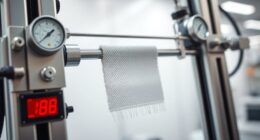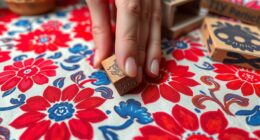If you’re looking for the best flame-test kits for fiber identification, I recommend the ALDON Flame Test Metal Identification Experiment Kit for precise spectral analysis and engaging experiments. Additionally, consider a kit with strong safety features and easy-to-use components, like a fiber-specific flame-test kit designed for quick, reliable results. Both options balance accuracy, safety, and usability, making your testing more effective. Keep exploring to discover essential features that will enhance your fiber analysis experience.
Key Takeaways
- Look for kits with high-quality spectroscopes and diffraction slides for accurate fiber analysis.
- Ensure the kit includes safety features like burn-resistant mats and protective eyewear for safe testing.
- Choose kits that offer clear instructions and easy-to-use components suitable for non-experts.
- Consider kits with spectral analysis capabilities to identify fiber elements through flame emission spectra.
- Prioritize durability and reusability of materials for cost-effective, ongoing fiber identification testing.
ALDON Flame Test Metal Identification Experiment Kit

If you’re looking for a flame test kit that’s ideal for small group learning and hands-on science experiments, the ALDON Flame Test Metal Identification Experiment Kit is a strong choice. It’s designed to help students identify metal elements by observing the colors they produce during combustion. The kit includes everything needed for safe, engaging experiments, such as spectroscopes and flame candles. It’s perfect for classrooms, remote learning, or home labs, allowing students to analyze spectral lines and deepen their understanding of atomic emission spectra. While some users note limited materials, it offers a practical way to explore metal identification through flame colors.
Best For: educators and students seeking a safe, hands-on flame test kit for small group experiments, remote learning, or home labs to identify metal elements via flame colors and spectral analysis.
Pros:
- Includes all necessary materials for safe and comprehensive metal identification experiments
- Facilitates engaging, hands-on learning about atomic emission spectra and spectroscopic analysis
- Suitable for small groups, remote learning, and homeschooling environments
Cons:
- Limited materials may restrict the number of groups or experiments
- Some users report issues with documentation quality and accuracy
- Higher cost relative to the amount of materials provided
Household Hemoglobin Test Kit with Test Strips

The Household Hemoglobin Test Kit with Test Strips is designed for individuals who want quick, convenient blood hemoglobin monitoring at home. It includes an analyzer, 25 test strips, sample tubes, a lancing pen, lancets, and a storage bag. The device provides results in just 15 seconds, with a testing range of 4.5-25.6 g/dl and a sample volume of 10μl. It’s portable, easy to operate—requiring simple steps like inserting a test strip and collecting a sample. Although some users report discrepancies compared to lab results, many appreciate its speed and convenience for regular monitoring. Proper setup and understanding instructions are key for accurate readings.
Best For: individuals seeking quick, convenient, and regular hemoglobin monitoring at home who are comfortable with device setup and aware of potential variances from lab results.
Pros:
- Rapid results in just 15 seconds for easy and timely monitoring
- Portable and user-friendly design suitable for home use
- Includes comprehensive components like test strips, sample tubes, and lancing device for complete testing
Cons:
- Some users report discrepancies and lower readings compared to lab results
- Setup can be complicated, with possible issues like code chip expiry or device malfunctions
- Instructions may be difficult to understand, affecting ease of use and accuracy
Factors to Consider When Choosing Flame‑Test Kits for Fiber ID

When selecting a flame-test kit for fiber identification, I consider safety features and the materials used to make certain my protection. I also look for accuracy, reliability, and how easy the kit is to operate, since these affect results and convenience. Ultimately, I weigh the cost and whether the kit offers spectral analysis capabilities for more precise identification.
Safety Features and Materials
Have you ever wondered how safe a flame-test kit truly is? Safety features are essential for protecting users during fiber identification. Look for kits that include burn-resistant mats and protective eyewear, which prevent injuries from accidental sparks or splashes. Materials matter too—non-toxic chemicals and flame-resistant containers help reduce health and environmental risks. The kit’s components should be designed to minimize spills and exposure to hazardous substances, ensuring safer handling. Clear safety instructions and proper handling guides are vital, so you know how to avoid fire or chemical accidents. Additionally, the construction should incorporate durable, heat-resistant materials to contain flames securely and prevent mishaps. Prioritizing these safety features and materials helps create a safer testing environment for everyone involved.
Accuracy and Reliability
Ensuring safety features are in place is important, but equally vital is selecting a flame-test kit that delivers accurate and reliable results. The accuracy depends on high-quality, well-calibrated spectroscopic components like diffraction slides and spectroscopes. Reliable kits use standardized chemicals and procedures, guaranteeing consistent color emissions for precise metal ion identification. Variability in flame color intensity and spectral line clarity can impact results, especially with low-concentration samples. Proper training and strict adherence to testing protocols are essential to minimize human error and improve accuracy. Including control samples or reference spectra in the kit also boosts confidence in the results and helps verify reliability. Choosing a kit with these features ensures your fiber identification is both precise and dependable.
Ease of Use
Choosing a flame-test kit that’s easy to use can substantially streamline fiber identification, especially for those without extensive chemistry experience. Clear, step-by-step instructions make the testing process straightforward and reduce mistakes. Lightweight and portable kits are ideal for quick setup in the field or classroom, allowing for efficient testing anywhere. An intuitive design, with color-coded components and simple procedures, helps prevent user errors and speeds up the process. Visual aids like spectral charts or color guides assist in accurate interpretation of flame colors without requiring expert training. Additionally, kits that feature minimal sample preparation and need fewer tools make fiber testing accessible to beginners. Overall, user-friendly features ensure that even non-experts can confidently perform flame tests with reliable results.
Cost and Value
When selecting a flame-test kit for fiber identification, evaluating cost and value is key to making a smart investment. Prices vary widely—some kits offer extensive materials for multiple tests, while others provide only basic components at a lower cost. To get the best value, check if the kit includes essential items like spectroscopes, test strips, or multiple flame colors, which enhance its usefulness. Durability is also important; reusable materials can save money over time despite a higher upfront price. Cheaper kits might seem budget-friendly but often lack enough materials for repeated testing, reducing their overall value. Comparing the quantity and quality of included components against the price helps ensure you choose a kit that offers good worth relative to its cost.
Spectral Analysis Capabilities
Spectral analysis capabilities are essential for accurately identifying fibers through flame tests, as they allow us to examine the emitted light spectra for specific metal ions. Using spectroscopes, I can observe detailed spectral lines that reveal the presence of particular elements, increasing identification accuracy beyond simple color observation. These kits can detect multiple elements simultaneously if their emission lines are distinguishable within the spectrum. High-resolution spectral analysis provides even greater precision by resolving closely spaced lines that might appear as a single color to the naked eye. The quality of spectral analysis largely depends on the diffraction or spectroscopic components included in the kit, which influence how clearly I can see and interpret spectral lines. Better components lead to more reliable and detailed fiber identification results.
Frequently Asked Questions
How Safe Are Flame-Test Kits for Home Use?
Flame-test kits can be safe for home use if you follow proper precautions. I always wear safety goggles and work in a well-ventilated area to avoid inhaling fumes. It’s crucial to use small amounts of chemicals and keep a fire extinguisher nearby. If you’re unsure or inexperienced, I recommend consulting with a professional or doing thorough research to make certain you’re handling everything safely.
Can Flame Tests Identify Synthetic Fibers Accurately?
Ever wonder if flame tests can truly identify synthetic fibers? I’d say they’re somewhat accurate but not foolproof. Synthetic fibers like polyester or nylon melt or burn differently, giving you clues, but they can be tricky if fibers are blended or damaged. So, while flame tests are useful as a quick initial check, I always recommend lab analysis for definitive results. Don’t rely solely on them for precise identification.
What Is the Learning Curve for Beginners Using These Kits?
The learning curve for beginners using flame-test kits is moderate. I found that with some practice, I quickly got the hang of observing flame colors and patterns. At first, it’s a bit tricky to distinguish subtle differences, but as I gained experience, it became easier. Patience and repeated tests help build confidence. Overall, I’d say anyone new can master these kits with consistent practice and careful attention.
Are There Any Environmental Concerns With Disposal?
Did you know that improper disposal of chemical flame-test kits can harm the environment? I’ve found that most kits contain small amounts of chemicals that, if not disposed of properly, can contaminate water sources. I always recommend following local hazardous waste disposal guidelines. It’s essential to handle and dispose of these chemicals responsibly to minimize environmental impact and keep our environment safe.
How Long Does It Typically Take to Get Results?
Results from a flame-test kit usually come within a few seconds to a minute. I find that the quick reaction helps me identify fibers efficiently without much waiting. Sometimes, if I need more detailed info, I might wait a little longer for confirmatory tests. Overall, it’s a fast process, making it ideal when quick results are essential. Just remember, proper technique guarantees accurate and reliable outcomes every time.
Conclusion
Choosing the right flame-test kit is like selecting the perfect brush for a masterpiece—each tool brings its own unique stroke to the canvas of fiber identification. Whether you prioritize precision, safety, or value, these kits serve as your trusted guides through a colorful labyrinth of fibers. With the right kit in hand, you’ll reveal the hidden stories woven into every strand, turning a simple flame into a beacon of clarity and discovery.










